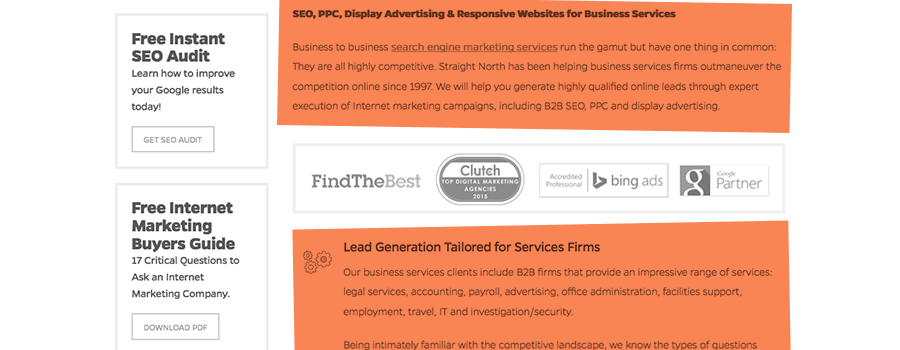
How To Write SEO Content That Drives Leads
The reason clients invest in SEO is to drive traffic that converts into sales leads or online revenue. SEOs can never lose sight of the fact that without persuasive content, all the traffic in the world won’t translate into new business. So what makes SEO content persuasive? Here are several thoughts on this very important issue.
Start with Research
Keyword research should be completely nailed down before the SEO copywriter starts writing. Without knowing what keyword phrases (and variations) to incorporate on the page, the copywriter will be forced at a later point to work keywords into the content. More often than not, this backward process results in choppy content that flows poorly and doesn’t convey important selling points clearly enough to spark conversions.
Keyword Density
Years ago, the best practices for keyword insertion in terms of number and spacing of repetitions were quite rigid. Today, there isn’t an exact protocol; Google crawlers can figure out the subject matter of a Web page without being shown a mechanical structure of exact keyword phrases. The important thing for the copywriter is to use the keywords when they are needed, and make all of the content on the page as relevant as possible to the theme.
Quality Content

Every article about online copywriting advises companies to create quality content. What is it, exactly? There are five signs of quality every piece of SEO content should have:
- Original. Plagiarism is definitely out; it’s an unacceptable business practice that serves no true SEO purpose anyway. Beyond that, if content says the same thing that’s been said a million times before, Google will be able to detect that just as easily as human readers — and will rank that content accordingly.
- Useful. To say something that hasn’t been said a million times, write to inform or educate the customer and prospect in ways that solve their problems or provide important benefits. Every business has unique insights; the challenge is to get that information out of the heads of the client’s staff and into the hands of the copywriter.
- Engaging. Not only does Google look for useful content, but also entertaining and sharable content. Dry, lifeless content is not effective for generating leads, nor does the average business reader embrace it. Google knows this, and does not like serving results their search engine users probably won’t enjoy reading.
- Relevant. I mentioned relevance earlier, and it is definitely relevant to mention it again! The issue of relevance again shows how much Google and humans are on the same page (no pun intended) when it comes to lead generation. Human readers are turned off when the content of a Web page doesn’t match expectations when they clicked on the link. Result: those human readers don’t convert. Similarly, when Google detects a gap between the content of a page and its title and/or meta information, it senses manipulation, and ranks the content accordingly.
- Error Free. Business content should be professionally edited and proofread, to make it coherent, factually accurate and free of grammatical and spelling errors. As an SEO, I get frustrated when all the hard work of keyword research and content creation is undermined by simple mistakes that turn off website visitors. Potentially great sales leads are thrown away simply through carelessness. Don’t let it happen to your clients!
Content Length
As with keywords, word count for SEO content is no longer an exact science. The main thing is to write enough content to tell the story in a way that inspires visitors to call or submit an inquiry form. As a rule of thumb, we benchmark 1,250 words for product category/service pages. For complex product/service offerings, content can run longer, but it is usually unwise to add word count just for the sake of some perceived or suspected SEO benefit. Whatever SEO gains (if any) achieved by the higher word count will be more than offset by the loss of conversions through boring or confusing visitors.
Content Elements

SEO copywriters need to pay special attention to these content elements on strategic SEO product/service pages:
- H1 Titles. The page title should include the primary keyword phrase for the page and be attention-getting. All the keyword brilliance in the world won’t get conversions if readers don’t become interested in reading about the product/service.
- H2, H3, H4 Titles. It’s nice when subheads include keywords, but perhaps even more important, subheads should be informative and engaging — since readers will use subheads as a primary method of scanning. Most studies I’m familiar with show that titles and subheads are read far more frequently than body text. They have to be good.
- Introductory Text. A good product/service page starts with an “executive summary” that highlights the most important benefits and (sometimes) features. Lose readers here, and you will lose leads.
- Secondary Text. Some readers won’t be content to just scan; they will be interested in product/service details. Secondary text should provide them with an education, but balance this with a good lead generation funnel. Some clients err by giving too much information, trying to replace the sales department with a Web page. The challenge is to provide enough information to make research-minded prospects inquire, but not so much as to make them feel it is unnecessary to inquire.
- Design Element Text. Photo captions and call-to-action boxes draw reader attention and should be written with utmost skill. This is why we want our SEO copywriters to have a solid grasp of conversion rate optimization and user experience best practices.
- Calls to Action. With regard to calls to action, we find it extraordinarily helpful to talk through the strategy with the copywriter, so that he or she understands what the audience is, what stage of the buying cycle the call to action is appealing to, the specific benefits of the offer, and what happens after the visitor calls or submits a form. This information enables the copywriter to boil down the message to the least number of words without losing accuracy (relevance) or sacrificing flair.
Content Is SEO’s Best Friend
When our content checks most or all of the boxes discussed in this post, our SEO team is pretty confident our SEO campaign will generate high-quality sales leads for the client. In the long term, we see Google putting even more emphasis on quality content, so the standards for what quality content is will continue to go higher. Every agency should be asking: Are we ready for it?




